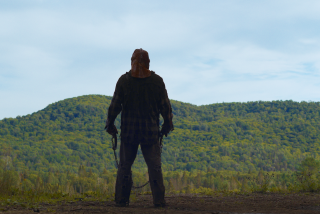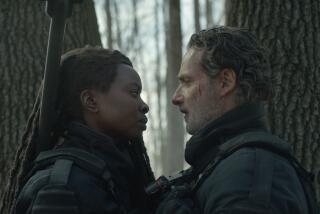Television review: AMC’s ‘The Walking Dead’ and IFC’s ‘Dead Set’
Zombies are back in a big way this Halloween, with “The Walking Dead” premiering on AMC and the British miniseries “Dead Set” on IFC. Frankly, it’s not a moment too soon. We’ve all but ruined all the other good monsters, turning perfectly decent vampires and werewolves into sad-eyed pin-up boys (and girls), reducing the dimensions of evil and corruption they once represented to eternal adolescent angst.
But zombies, well, there’s not much you can do to a zombie. You can fiddle with their land speeds and their raison d’être (Worldwide pandemic? Overbooking in hell?) but there ain’t no way you’re going to make a zombie sexy. Not even the mopey, seasonal-disorder-plagued Bella could fall for a guy whose jawbone is hanging by a decayed thread.
Which doesn’t mean zombies aren’t complicated. While vampire mythology revolves around sex, and werewolves embody the animal in every man, zombies are more sociopolitical. Originally, zombies were created by voodoo to work the Haitian fields — the ultimate proletariat. They shook off their chains in the 1950s through “Tales From the Crypt” comic books and the novel “I Am Legend,” but it wasn’t until 1968 that they found their true leader. In “Night of the Living Dead” George Romero turned corpses into the ultimate power-consumers, and created the Rosetta stone of the genre.
“The Walking Dead” and “Dead Set” share the standard zombie apocalypse plotline and a slavering, saturated, graphically detailed grisliness (fake blood and disembowelment technology have certainly improved since “Night of the Living Dead,” or even “Braveheart”) but are quite different in ambition, message and execution. “Dead Set,” which aired in Britain last year as a five-part, 21/2-hour series, is a smaller and more pointed social commentary. As news reports of zombies fill the air, the crew of “Big Brother” remains oblivious and soon Charlie Brooker’s tale turns the reality show’s conceit inside out — the house is now one of the few safe places in the world and the ever-shrinking few must work together to survive.
Though not as broad a satire as the marvelous 2004 film “Shaun of the Dead,” “Dead Set” imagines how ordinary people might actually act in a zombie-intense situation while brilliantly sending up the mindless nature of “Big Brother.” When the stricken go zombie, their eyes resemble the show’s logo and in one particularly harrowing scene, a literal evisceration is accompanied by a metaphorical one — Brooker is no fan of reality TV.
Based on the popular graphic novel, “The Walking Dead” is much more ambitious in both scope and tone. (For the record, it also had the most impressive display at this year’s Comic-Con.) Writer and director Frank Darabont (“ The Shawshank Redemption,” “The Green Mile”) seamlessly stitches together grand American traditions including the western, the separated-family drama and, of course, the post-apocalypse tale, creating the first zombie epic, with sprawling storylines, archetypal characters and imagery to rival “Gone With the Wind.”
Our hero is Southern sheriff Rick Grimes (Andrew Lincoln) who, after a mood-setting opener, we meet as he is engaged in a manly discussion of relationships with his partner Shane ( Jon Bernthal). Soon they are part of a shoot-out leaving Grimes wounded. As with the zombie-hybrid “28 Days Later,” it is a coma that saves him — Grimes awakens to an empty, shattered hospital and a world gone mad. Making his way home through a maze of corpses and zombies, he finds his wife and son gone. Father and son survivors take him in, explaining the nature of “the walkers” — hewing to good zombie tradition, they don’t move very fast but are dangerous in packs; they can only be killed by destroying their brains.
On the topic of why and when, they are maddeningly elliptical and Grimes is less than curious. But when he learns of an emergency center in Atlanta, he decides that is where his family is and he’s off, after stocking up on weaponry and finding himself a horse.
You can’t help but feel that the image of the lawman on horseback clip-clopping along an empty freeway toward a city overrun by zombies jumpstarted this whole project — it is a terrific scene, the still silence much more terrifying than any entrail chewing could ever be. Darabont understands that in horror, pacing is everything, and in the first two episodes he uses nature wonderfully — green fields and sylvan parks belie the chaos that is currently humanity, while empty streets and images of debris remind us of the futility of possessions.
Except, of course, guns. Guns are key — to Grimes, to the scrappy band of survivors he meets in the city and to the other survivors in the forests. The downside of zombies is their method of destruction. Vampires and werewolves require at least a small amount of forethought and ritual; zombies you just shoot in the head. And although “The Walking Dead” is clearly a sophisticated story of how civilization reassembles itself in the wake of disaster, there are still a lot of zombies wandering around. Which invariably requires scenes that resemble a video game and leaves one wondering if the whole zombie genre wasn’t dreamt up as a way to justify shooting a bunch of people in the head without feeling guilty. (The only thing less morally troublesome to kill is a Nazi zombie, which is a very popular part of the Call of Duty game series.)
In an early scene we see the emotional toll the killings can take and in several instances, Grimes and others pay homage to the former humanity of their predators. But still, zombies are clearly not human. Or rather they are the nightmare version of humanity, the fear that our friends and family are not to be trusted because they are capable of turning on us at any time.
That same anxiety is played out among the survivors — the suspicion that what civility we have is merely a habit, that any shift in the order of things will reveal the hidden bullies and tyrants, the murderers and rapists and thieves. “The Walking Dead,” like any good horror tale, still believes in the importance of monsters, perfectly balancing the struggle of basic human decency with those palsied four-in-the-morning moments when we are convinced that everyone around us is trying to eat us alive.
More to Read
The complete guide to home viewing
Get Screen Gab for everything about the TV shows and streaming movies everyone’s talking about.
You may occasionally receive promotional content from the Los Angeles Times.







